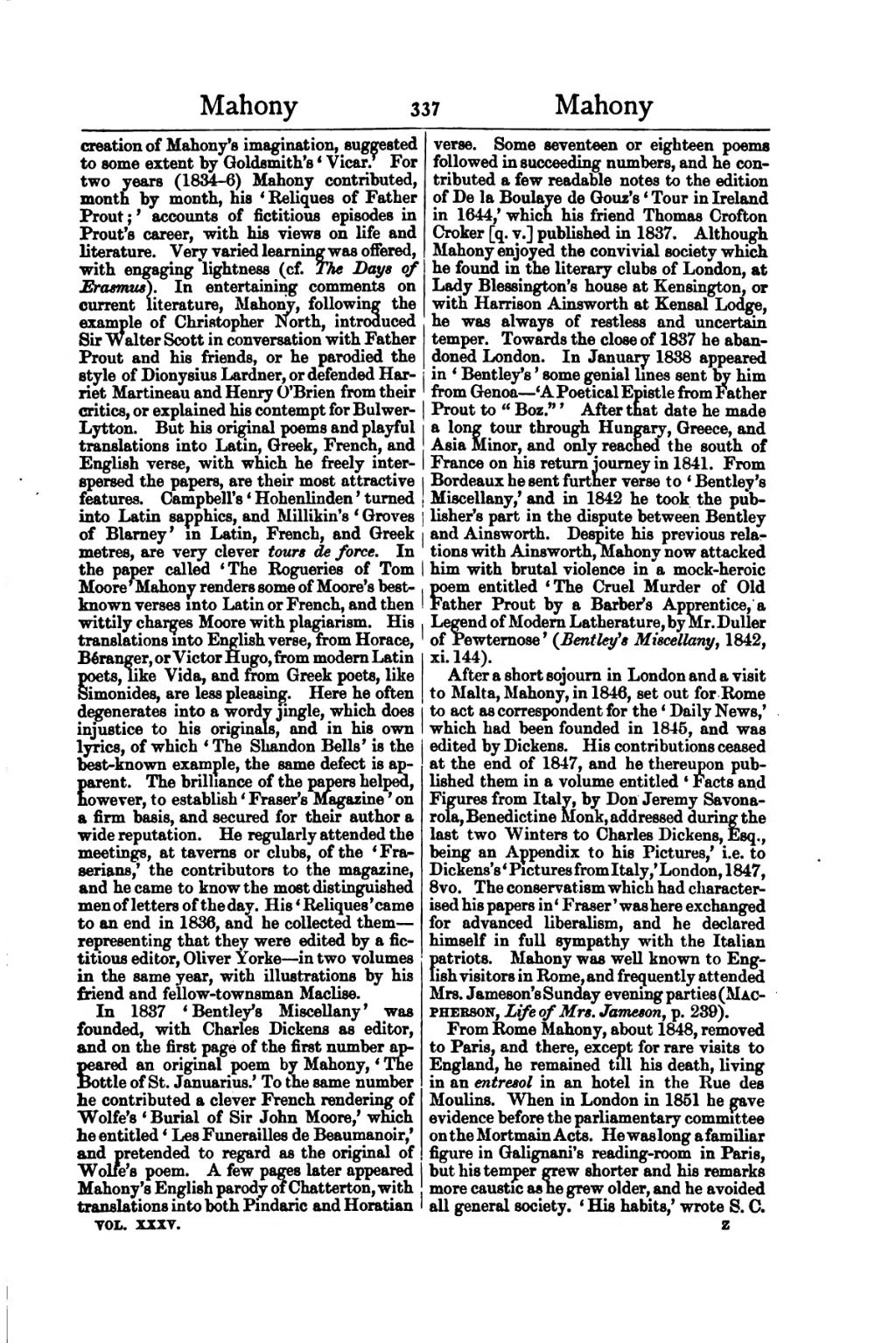creation of Mahony's imagination, suggested to some extent by Goldsmith's ‘Vicar.’ For two years (1834–6) Mahony contributed, month by month, his ‘Reliques of Father Prout;’ accounts of fictitious episodes in Prout's career, with his views on life and literature. Very varied learning was offered, with engaging lightness (cf. The Days of Erasmus). In entertaining comments on current literature, Mahony, following the example of Christopher North, introduced Sir Walter Scott in conversation with Father Prout and his friends, or he parodied the style of Dionysius Lardner, or defended Harriet Martineau and Henry O'Brien from their critics, or explained his contempt for Bulwer-Lytton. But his original poems and playful translations into Latin, Greek, French, and English verse, with which he freely interspersed the papers, are their most attractive features. Campbell's ‘Hohenlinden’ turned into Latin sapphics, and Millikin's ‘Groves of Blarney’ in Latin, French, and Greek metres, are very clever tours de force. In the paper called ‘The Rogueries of Tom Moore’ Mahony renders some of Moore's best-known verses into Latin or French, and then wittily charges Moore with plagiarism. His translations into English verse, from Horace, Béranger, or Victor Hugo, from modern Latin poets, like Vida, and from Greek poets, like Simonides, are less pleasing. Here he often degenerates into a wordy jingle, which does injustice to his originals, and in his own lyrics, of which ‘The Shandon Bells’ is the best-known example, the same defect is apparent. The brilliance of the papers helped, however, to establish ‘Fraser's Magazine’ on a firm basis, and secured for their author a wide reputation. He regularly attended the meetings, at taverns or clubs, of the ‘Fraserians,’ the contributors to the magazine, and he came to know the most distinguished men of letters of the day. His ‘Reliques’ came to an end in 1836, and he collected them—representing that they were edited by a fictitious editor, Oliver Yorke—in two volumes in the same year, with illustrations by his friend and fellow-townsman Maclise.
In 1837 ‘Bentley's Miscellany’ was founded, with Charles Dickens as editor, and on the first page of the first number appeared an original poem by Mahony, ‘The Bottle of St. Januarius.’ To the same number he contributed a clever French rendering of Wolfe's ‘Burial of Sir John Moore,’ which he entitled ‘Les Funerailles de Beaumanoir,’ and pretended to regard as the original of Wolfe's poem. A few pages later appeared Mahony's English parody of Chatterton, with translations into both Pindaric and Horatian verse. Some seventeen or eighteen poems followed in succeeding numbers, and he contributed a few readable notes to the edition of De la Boulaye de Gouz's ‘Tour in Ireland in 1644,’ which his friend Thomas Crofton Croker [q. v.] published in 1837. Although Mahony enjoyed the convivial society which he found in the literary clubs of London, at Lady Blessington's house at Kensington, or with Harrison Ainsworth at Kensal Lodge, he was always of restless and uncertain temper. Towards the close of 1837 he abandoned London. In January 1838 appeared in ‘Bentley's’ some genial lines sent by him from Genoa—‘A Poetical Epistle from Father Prout to “Boz.”’ After that date he made a long tour through Hungary, Greece, and Asia Minor, and only reached the south of France on his return journey in 1841. From Bordeaux he sent further verse to ‘Bentley's Miscellany,’ and in 1842 he took the publisher's part in the dispute between Bentley and Ainsworth. Despite his previous relations with Ainsworth, Mahony now attacked him with brutal violence in a mock-heroic poem entitled ‘The Cruel Murder of Old Father Prout by a Barber's Apprentice, a Legend of Modern Latherature, by Mr. Duller of Pewternose’ (Bentley's Miscellany, 1842, xi. 144).
After a short sojourn in London and a visit to Malta, Mahony, in 1846, set out for Rome to act as correspondent for the ‘Daily News,’ which had been founded in 1845, and was edited by Dickens. His contributions ceased at the end of 1847, and he thereupon published them in a volume entitled ‘Facts and Figures from Italy, by Don Jeremy Savonarola, Benedictine Monk, addressed during the last two Winters to Charles Dickens, Esq., being an Appendix to his Pictures,’ i.e. to Dickens's ‘Pictures from Italy,’ London, 1847, 8vo. The conservatism which had characterised his papers in ‘Fraser’ was here exchanged for advanced liberalism, and he declared himself in full sympathy with the Italian patriots. Mahony was well known to English visitors in Rome, and frequently attended Mrs. Jameson's Sunday evening parties (Macpherson, Life of Mrs. Jameson, p. 239).
From Rome Mahony, about 1848, removed to Paris, and there, except for rare visits to England, he remained till his death, living in an entresol in an hotel in the Rue des Moulins. When in London in 1851 he gave evidence before the parliamentary committee on the Mortmain Acts. He was long a familiar figure in Galignani's reading-room in Paris, but his temper grew shorter and his remarks more caustic as he grew older, and he avoided all general society. ‘His habits,’ wrote S. C.
